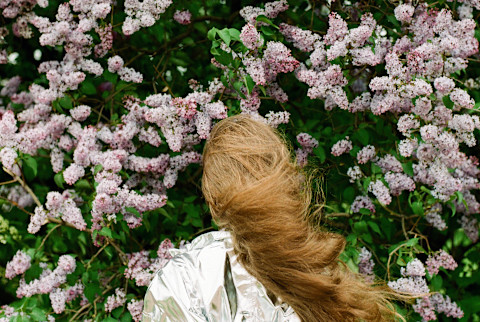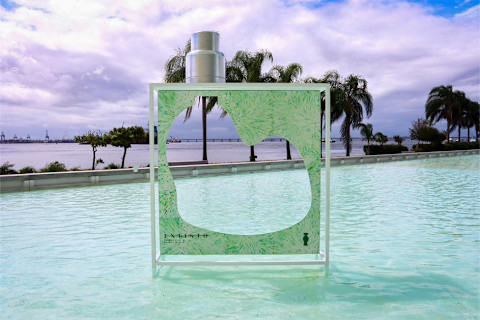Fragrance Can Help Us Remember The Past — But Can It Inspire A Better Future, Too?

I can’t wear perfumes with heavy notes of lilac. It reminds me too much of home during the spring and summer months, when the lilac bushes in our backyard would reach several feet tall and the air would fill with the aroma of the soft, airy floral. Anytime I smell it, I’m instantly homesick—aching for a time when my biggest concern was catching more fireflies than my brother.
Longing for moments you know you can’t go back to is one of the most excruciating forms of nostalgia.
Scent quite literally connects us to the past
We know through the science of olfactory memories that scent has a strong connection to memory formation and recall. Scent quite literally connects us to the past.
Here’s how it works: The amygdala plays a critical role in the formation, retention, and recall of memories1. The amygdala is also the part of the brain in charge of flight-or-fight response. Odors can directly engage with the amygdala, as the olfactory cortex and amygdala are right next to each other2 in the frontal lobe.
The adjacency makes sense from an evolutionary perspective, as our brains need quick, easy ways to identify if our surroundings are safe or not. Our brains have evolved to associate specific scents with feelings of safety or danger, so we can be on alert if needed—or relax when we’re in places that are familiar. All of this happens in an instant, before the other parts of the brain are able to process the other senses.
Research shows us how this plays out in real life: For example, one study found that fragrance can improve memory recall quicker and more effectively than language cues (and interestingly, the memories associated with scents were overwhelmingly positive). Other research shows that odor-induced memories that are associated with positive moments have the ability to reduce stress3.
So fragrance’s ability to prompt visions of the past is one that’s fairly well understood. But what about the future? Can fragrance help inspire a better future, one in which we take better care of ourselves and the natural world around us? Well, some brands think so.
Can fragrance inspire a better, more sustainable future?
The climate crisis is upon us, and affects us every day whether we choose to see it or not. For fragrance and beauty brands, the crisis is two-fold. The first is that the beauty industry creates a shocking amount of trash: It creates at least 120 billion pieces of packaging each year, with almost all of that ending up in landfills as less than 10% of beauty products actually get recycled.
But the second looming crisis is one that’s not as often discussed: resource loss. The natural world is the source of inspiration for almost all product ingredients (this is true for both lab- and naturally-derived ingredients). And we are losing biodiversity by the moment. Ecosystems that we used to turn to for their flora—hoping to find unique extracts that can be used to care for bodies—are disappearing, thanks to climate change, pollution, and waste.
O Boticário—a Brazilian-based beauty conglomerate that oversees several other brands such as NativaSpa—set out to bring awareness to this sobering fact with their newest project, Extinto. Created by the Brazilian creative agency AlmapBBDO in partnership with Boticário Group Foundation for Nature Protection (FGB), Extinto is a fragrance that captures the original scent of a now polluted Brazilian bay.
The bay is Rio de Janeiro’s Guanabara Bay, the second largest on the Brazilian coast. It was once a flourishing, lush natural habitat—but now has about 98 tons of waste dumped into it every day. (See more here.)
Extinto is the first of a collection of five fragrances that will span four continents, each capturing the original scent of a decimated ecosystem. The fragrance reminds us of what we’ve already lost, and what’s at stake if we continue to lose more. But also: What we could regain if we decided to focus our attention and action.
“Our goal is to bring awareness to the fragility of these natural paradises through our scents,” says Marcela De Masi, O Boticário Brand and Marketing Executive Director, noting that these fragrances are not commercial projects (ie: for sale to the mass audience), but rather an awareness campaign. “We hope to create a sensory experience that transcends traditional methods of raising environmental awareness. By tapping into the power of scent, we believe we can evoke a deeper emotional connection with nature, encouraging people to reflect on their role in safeguarding our planet's natural wonders.”
How did they recreate a lost scent?
To capture the “original scent,” the creators went to protected parts of the bay that were unscathed from pollution.
It has notes of “the bay’s cool waters and the vibrant green of the forests surrounding it,” the brand says. They also note that the “the product is vegan, made up of 93% natural, traceable, organic, circular-chain ingredients, as well as a small percentage of synthetic elements.”
Other fragrance companies have made the connection between the power of scent and sustainability.
For example, back in 2014 fragrance giant Givaudan (who creates notes and flavors for perfume and food companies), artist Catherine Sarah Young, and collective The Apocalypse Project created a collection of perfumes that evoked scents that could disappear with climate change. It was called The Ephemeral Marvels Perfume Store, and included fragrances such as Honey, Ice, Coffee, and Eucalyptus.
Or the new fragrance brand Air, which makes an Eau de Parfum out of captured CO2. Using a patented technology that takes damaging CO2 and converts it into carbon negative alcohol, it’s the world’s first carbon negative perfume.

Finding our way home
With each year, more and more damage is done to the planet: Temperatures continue to climb, plastic is added to our oceans, biodiversity is decimated, and climate events spiral into catastrophes.
I feel like everytime I look at the news, it’s a story about how the plant has changed irrevocably or we’re barreling toward another apocalyptic deadline. Last year was the hottest on record“by a clear margin.” And considering January and February were also the hottest on record, 2024 might have a similar trajectory. In terms of biodiversity, wildlife populations have declined almost 70% since 1970. And without intervention, annual plastic production is expected to increase 22% between 2024 and 2050.
But it’s not just news stories and faraway places that remind me of what’s at stake. I think back to the simple, powdery smell of the lilac flower.
I live in New York City now, where I’m not as readily surrounded by lilac bushes, which means it's been several years since I’ve smelled its bloom. But even in a future in which I flee city life, create a home in the midst of nature, and plant a garden of lilac bushes for myself and any future children, one element could be missing: The firefly.
The insects’ population has been dwindling over the past several years across the globe. This loss is due to climate change, light and water pollution, pesticide use, and habitat destruction. Experts estimate 1 in 3 species of fireflies4 are at risk of extinction in North America alone. One of childhood’s simplest pleasures, lost. And so, the memories I associate with the smell of lilac may become just that: memories. Distant, irreplaceable memories.
One of the main challenges of conceptualizing the imminent dangers of climate change is that it feels too big to grasp. But perhaps that’s exactly why fragrance is the perfect medium to remind us what’s at stake.
“The consequences are dire, as pollution threatens the beauty and original fragrance of natural areas worldwide. It is our mission to go beyond a mere fragrance collection and serve as a global wake-up call, highlighting the significance of conserving our environment so that future generations can also revel in the essence of these natural paradises,” De Masi told me.
In the end, it all comes back to the science of how olfactory scents work: Through evolutionary need, our brains have have developed to use scent as the first identifier of danger. It alerts us to be on edge—well before the conscious part of the brain can grasp how threatening the situation really is.
However, smell is also the first thing to let us know we are safe—that we are home.
4 Sources
- https://pubmed.ncbi.nlm.nih.gov/24583373/#:~:text=The%20amygdala%20has%20long%20been,anterior%20medial%20temporal%20lobe%20region.
- https://www.ncbi.nlm.nih.gov/pmc/articles/PMC217997/#:~:text=Importantly%2C%20the%20amygdala%20is%20continuous,upon%20the%20primary%20olfactory%20cortex.
- https://www.ncbi.nlm.nih.gov/pmc/articles/PMC5039451/
- https://journals.plos.org/plosone/article?id=10.1371%2Fjournal.pone.0259379&itid=lk_inline_enhanced-template
